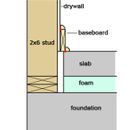ADA sealant recommendation please
Hello,
I’d like to air seal my baseboards to my drywall and concrete slab as part of an ADA.
What would you guys use to seal wood to acrylic paint & unfinished concrete?
I picked up some GE Silicone II Gutter & Flashing which says it sticks to wood and concrete, but was wondering if there was a better choice.
Thanks for your help,
-Richard
GBA Detail Library
A collection of one thousand construction details organized by climate and house part











Replies
Silicone is not what you want--it is an incredible mess if you have to wipe it, and paint does not stick to it.
Get yourself some acrylic latex painter's caulk. It will work great between baseboard and wall, and should work fine between baseboard and slab assuming the slab is dry and not wicking a lot of moisture through it (almost impossible for me to imagine a failure there, although acrylic latex does not work that well around shower bases).
Use a tilesetter's sponge and t-shirt rags, and a small bucket of water, and you can do very clean work with acrylic caulk. If you go to the tile aisle, you can buy quite a few different colors that might match better than white or almond.
Richard,
A wide variety of caulks will work. Polyurethane caulk is particularly tenacious and durable, but it is sometimes challenging to clean up, so apply it carefully.
Martin, "sometimes" is not a word I would use in a sentence describing the potential difficulty of cleaning up polyurethane sealant. I use Sikaflex 1a all the time, and the only way to clean it up is with paint thinner. The pigments in it stain everything. I can think of virtually no time that I would use it indoors. If something possesses a person to do so, they should painstakingly mask both sides of every gap they are going to caulk, and avoid getting *any* material on surfaces where they don't want it.
Silicone caulk now comes in a paintable grade.
It's still a mess to work with compared to latex, but I've seen demonstrations where the installer sprays on alcohol prior to tooling it, which reduces the problem of the caulk making such a mess.
It also comes in limited colors (like white and almond) as well as the usual clear.
I don't know what affect the formulation for making it paintable does to the quality compared to the non paintable. Anybody have info on this?
Martin, what's your preference for wet areas like showers?
Richard,
Are you sure it wouldn't be easier and more effective to seal the drywall to whatever that vertical filler is that runs between the framing and the slab? A bead if acoustic sealant there and you are done.
谢谢你的recommendations guys. It was the lifespan of silicone that initially appealed to me.
Malcolm: I stuffed the void between framing and slab with pieces of fiberglass. It's a large nonuniform gap (~3/4") making it difficult to seal. I considered tape, formed metal strips, spray foam and gaskets. I don't like gluing things down, but it seems like the way to go.
Richard,
Then I'd use what David suggested. I've had good results with Dap paintable acrylic latex. Very forgiving.